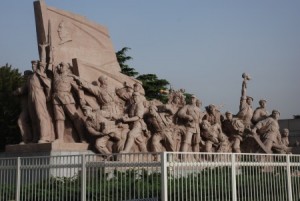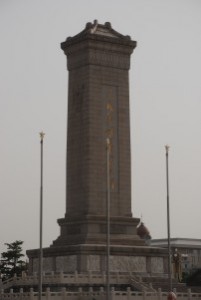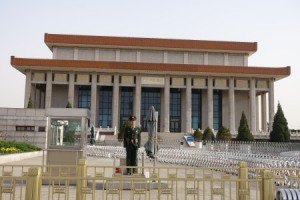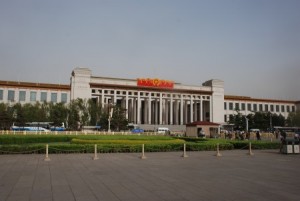
A visit to Beijing would not be complete without a stop at Tiananmen Square. The square is named after the Tiananmen gate (gate of heavenly peace) which is on the north end of the square. Tiananmen Square measures almost a kilometre long and half a kilometre wide. It is located at the center of Beijing City. This noteworthy historical site is the home for the Tiananmen Tower, Monument to the People’s Heroes, Great Hall of the People, Chairman Mao Zedong Memorial Hall and the daily the national flag raising ceremony.
Brief History of Tiananmen Square
The Tiananmen Gate dates back to the fifteenth century (Ming Dynasty). The original square was built in the 17th century and quadrupled in size in the 1950s. After Mao’s death in 1976, the size was expanded again.
In modern times, Tiananmen has become the political symbol of China. The government has used it as a platform to promote their agenda while demonstrators have likewise used it to voice their opposition to the government.
The following is a sampling of notable historical events that have taken place in Tiananmen:
- March 1900- Victory March by Allied Army celebrating occupation of Beijing.
- June 1917 Gen Zhang Xun’s commemorating restoration of his imperial order.
- May 1919- Demonstration to protest against the Treaty of Versailles’ handing over of Chinese lands to Japan.
- March 1926- Patriotic march.
- December 1935- Demonstration that initiated the resistance movement against Japanese invasion.
- May 1947- Anti-autocratic movement during Civil War.
- October 1949- Mao celebrating the founding of the People’s Republic and the defeat of the Nationalists under Chiang Kai-shek.
- 1960s- millions of Chinese gathered for National Day parades.
- April 1976- Memorial to former prime minister Zhou Enlai.
The most famous event took place in June of 1989. The Western world watched with disapproval as Chinese troops attack pro-democracy protestors. An unknown number of people died. Some websites estimate hundreds while others claim thousands. The world viewed this situation as a massacre. An untold number of protestors were imprisoned and killed while a select number were able to seek asylum in the western world.
Decades later, the facts remain a mystery. According to the Britannica.com website- “Public commemoration of the incident is officially banned.” CNN’s review of the National Museum of China states that “The building contains no exhibits mentioning the events of June 1989.”
I visited Tiananmen Square in the late afternoon for a photo stop. There were few people. All of the buildings were closed. While I was walking around taking pictures, I could only image the immense number of people who have flocked to this square during historical events.

In the north end there was an oversized flag pole and a large red building. The on sight map identifies the building as “Tian’anmen”.
Monument to the People’s Heroes

This modern granite structure is located in the center of the square. It was constructed in 1952. Engraved on the surface on Chairman Mao’s words, “The People’s Heroes are Immortal.” The development of modern Chinese history is depicted on 8 sculptures
Great Hall of the People
On the west side is the Great Hall of the People. It was built shortly after the Monument to the People’s Heroes in 1959. The building houses three distinct sections- three parts–the Central Hall, the Great Auditorium seats 10,000 and a Banqueting Hall that seats 5,000 people. The China National People’s Congress meetings and various political and diplomatic events take place in this building. The floor of the Central Hall is paved with marble and crystal lamps hang from the ceiling. Unfortunately, I do not have any exterior pictures and the building was closed when we arrived.

Memorial Hall of Chairman Mao
Memorial Hall of Chairman Mao is found at the south end of the Square. It has three halls. Chairman Mao’s body is in a crystal coffin in one of the halls. On either side of the Chairman Mao’s exterior portrait are two notable slogans- ‘Long Live the Chinese People’s Republic’ and ‘Long Live the Great Unity of the World’s Peoples’

China National Museum
The museum was opened in 2003. It is a history museum that highlights China’s long history and includes a separate section that focuses on the Chinese Revolution. This building was also not open at the tine of our visit. It would have been interesting to see which facts are included in their displays.
Reflecting on Visit
Throughout the world, there are places where people tend to congregate. These open spaces can accommodate enormous crowds and are remembered for their more prominent gatherings- some peaceful and some violent. Thus when visiting such places, it is natural to reflect not only on the present but also on the past events.
In Tiananmen Square, the 1989 protestors helped to usher in a new era. This place will always symbolize their wishes. Despite China’s massive effort to modernize its infrastructure, certain aspects of the former government and the people’s mindset remains.
Related Posts
What Cruisers Should Know About Multiple Days in Tianjin, China
Pre Cruise Exploration- Hong Kong
Sandra’s Bio
Sandra Bornstein is the author of MAY THIS BE THE BEST YEAR OF YOUR LIFE. It is available on Amazon. Sandra’s memoir highlights her living and teaching adventure in Bangalore, India. She is a licensed Colorado teacher who has taught K-12 students in the United States and abroad as well as college level courses. Sandra is married and has four adult sons. The memoir was a finalist in the Travel category for the 2013 Next Generation Indie Book Awards, the 2013 International Book Awards, the 2013 National Indie Book Excellence Awards, the 2013 USA Best Book Awards, and received an Honorable Mention award in the Multicultural Non-Fiction category for the 2013 Global ebook Awards.
Leave a Reply
You must be logged in to post a comment.